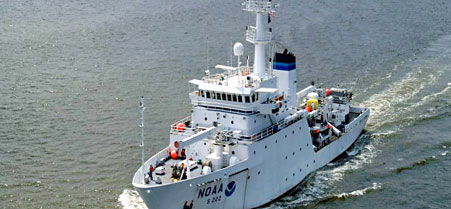NOAA sends high-tech research ship into Gulf
Scientists will take water samples to determine if suspended oil plumes are traveling far below the surface, depleting oxygen and threatening marine life.
 NOAA chief Jane Lubchenco says the
Thomas Jefferson
will find out what "goes on below the surface."
NOAA chief Jane Lubchenco says the
Thomas Jefferson
will find out what "goes on below the surface."
The high-tech research ship Thomas Jefferson , operated by the National Oceanic and Atmospheric Administration, sailed from New Orleans on Wednesday to determine if submerged oil is floating far below the surface of the Gulf of Mexico, threatening the wildlife in deeper waters.
Researchers from the University of Georgia reported on May 15 that they had discovered large oil plumes deep in the Gulf. Scientists fear the presence of the suspended oil could deplete oxygen in the water near the plumes, possibly killing marine life along wide swaths near the sea floor.
But NOAA Administrator Jane Lubchenco said the university's research, as well as other reports of subsurface oil in the Gulf, did not "provide definitive information . . . to say what is happening below the surface" of the water.
During the Thomas Jefferson's 10-day mission, crew members will rely on a combination of instruments that other researchers in the Gulf have used separately to determine what "goes on below the surface," she said in a press briefing.
In a separate briefing on Wednesday, which Coast Guard Adm. Thad Allen, the national incident commander, also attended, Lubchenco said the Thomas Jefferson has joined another NOAA ship, the Gordon Gunter , which has deployed an autonomous underwater vehicle called the Gulper, supplied by the Monterey Bay Aquarium Research Institute. The Gulper, which as its name implies, swallows water samples from below the surface of the ocean to analyze its chemical makeup.
Cmdr. Shepard Smith, captain of the Thomas Jefferson , said the crew will use a number of specialized instruments to develop "a robust methodology for the detection of submerged oil." The equipment will include a moving vessel profiler , a computer-controlled winch that deploys mechanical "fish" behind a ship. The fish carry a sensor that can detect oil up to 1,900 feet below the surface.
The Thomas Jefferson also will rely on a conductivity temperature depth instrument that measures the salinity and water temperature at different depths, Smith said. John Ryan, an oceanographer at the Monterey Bay Aquarium Research Institute, said the instrument will help determine the circulation of water in the Gulf.
The CTD is surrounded by a rosette of bottles that collect water samples. The rosette frame also will carry a sensor to measure water clarity below the Gulf surface, said David Hall, a NOAA spokesman.
He said the Thomas Jefferson also will attach an instrument called a flourometer to the rosette to detect oil. Last month, on another Gulf mission, the ship deployed a subsea glider from the Naval Oceanographic Office that contained a flourometer in its sensor package, which also was measuring oil below the surface.
The Thomas Jefferson also will use its onboard sonar systems to detect subsea oil plumes, Hall noted.
All the collected data will be processed aboard the ship and then will be transmitted by an onboard satellite system to the unified command managing the federal response to the Gulf oil disaster. Hall said water samples collected by the bottles on the rosette will be processed by an onboard chemist, and when the ship docks, they will be sent to a lab for analysis.
Ryan said the Gulper packs some of the same instruments as those the Thomas Jefferson will deploy, including a CTD, a flourometer and optical sensors that can detect algae and oil below the surface of the Gulf.
The Gulper also carries 10 bottles to scoop up water samples and uses an onboard computer system loaded with artificial intelligence software to guide its mission. Ryan said scientists have programmed the Gulper to think like they do so that, for example, it can collect samples while operating autonomously.
Ryan said the challenge for the entire marine science community working on the Gulf oil disaster is to rely on sensor systems to detect oil in deep water, monitor its make up as it ages, how far it travels and its affect on the environment. "All marine researchers have responded rapidly, but this is new to everyone," he noted.
NEXT STORY: How Far Would You Drive for Billions?



